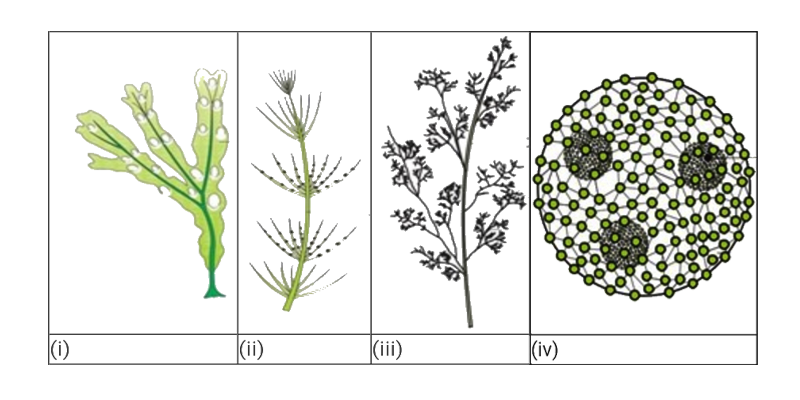Which of these algae exhibit the haplo-diplontic life cycle?
fucus, ulothrix
ectocarpus, polysiphonia
volvox, Laminaria
Spirogyra, laminaria
To determine which of the listed algae exhibit a haplo-diplontic life cycle, we will analyze each option based on the characteristics of this life cycle.
1. Understanding Haplo-Diplontic Life Cycle:
- The haplo-diplontic life cycle involves both haploid (n) and diploid (2n) stages.
- In this cycle, the organism alternates between a multicellular haploid phase (gametophyte) and a multicellular diploid phase (sporophyte).
2. Analyzing Each Alga:
- Fucus: This brown alga exhibits a haplo-diplontic life cycle, where both gametophyte and sporophyte stages are multicellular.
- Eulothrix: This green alga primarily reproduces asexually and does not exhibit a haplo-diplontic life cycle.
- Ectocarpus: This alga shows a haplo-diplontic life cycle with both haploid and diploid phases, including asexual reproduction through zoospores.
- Polysiphonia: This red alga has a triphasic life cycle that includes haploid and diploid phases, thus it also exhibits a haplo-diplontic life cycle.
- Volvox: This green alga primarily reproduces asexually and does not exhibit a haplo-diplontic life cycle.
- Laminaria: This brown alga exhibits a haplo-diplontic life cycle with distinct multicellular haploid and diploid phases.
- Spirogyra: This green alga primarily reproduces sexually through conjugation and does not have a distinct haplo-diplontic life cycle.
3. Conclusion:
- The algae that exhibit the haplo-diplontic life cycle from the given options are Fucus, Ectocarpus, Polysiphonia, and Laminaria.
Final Answer:
The algae that exhibit the haplo-diplontic life cycle are: Fucus, Ectocarpus, Polysiphonia, and Laminaria.
- The haplo-diplontic life cycle involves both haploid (n) and diploid (2n) stages.
- In this cycle, the organism alternates between a multicellular haploid phase (gametophyte) and a multicellular diploid phase (sporophyte).
- Fucus: This brown alga exhibits a haplo-diplontic life cycle, where both gametophyte and sporophyte stages are multicellular.
- Eulothrix: This green alga primarily reproduces asexually and does not exhibit a haplo-diplontic life cycle.
- Ectocarpus: This alga shows a haplo-diplontic life cycle with both haploid and diploid phases, including asexual reproduction through zoospores.
- Polysiphonia: This red alga has a triphasic life cycle that includes haploid and diploid phases, thus it also exhibits a haplo-diplontic life cycle.
- Volvox: This green alga primarily reproduces asexually and does not exhibit a haplo-diplontic life cycle.
- Laminaria: This brown alga exhibits a haplo-diplontic life cycle with distinct multicellular haploid and diploid phases.
- Spirogyra: This green alga primarily reproduces sexually through conjugation and does not have a distinct haplo-diplontic life cycle.
- The algae that exhibit the haplo-diplontic life cycle from the given options are Fucus, Ectocarpus, Polysiphonia, and Laminaria.
The algae that exhibit the haplo-diplontic life cycle are: Fucus, Ectocarpus, Polysiphonia, and Laminaria.
Topper's Solved these Questions
Similar Questions
Knowledge Check
Haplo-diplontic life cycle is found in
AbryophytesBpteridophytesCfungiDboth a and bWhich of the statements regarding haplontic life cycle is incorrect?
ASporophytic generation is represented only by the one-called zygote.BThere is no free-living sporophyte.CMitosis in the zygote results in the formation of haploid spores.DThe haploid spores divide mitotically and form the gametophyte.
Haplodiplontic life cycle is observed in
View SolutionWith the help of a schematic diagram describe the haplo-diplontic life cycle pattern in plants.
View SolutionAlgal member with diplontic life cycle is
View SolutionWhich of the following pairs of organisms are correctly matched with their description ?
1. Pteridophytes which are heterosporous : Selaginella , salvinia
2. Gymnosperms with branched stem : Pinus , Cedrus
3. Algae with haplo - diplontic life cycle : Ectocarpus, polysiphonia
4. Bryophytes with protonema stage : polytrichum , sphagnum
View SolutionRead the following statements.
(a) Volvox does not have a free living sporophyte.
(b) All alga show haplontic life cycle.
(c) Sporophyte of Fucus is dominant and photosynthetic.
(d) All seed bearing plants have diplontic life cycle
(e) Bryophytes have haplodiplontic life cycle
Select the option with correct set of statements.
View SolutionStatement I : Diplo-haplontic or haplo-diplontic life cycle is characterized by the existence of a sporophyte ae wall as a gametophyte.
Statement II : Fungi have a haplo-diplontic life cycle .
View Solution

